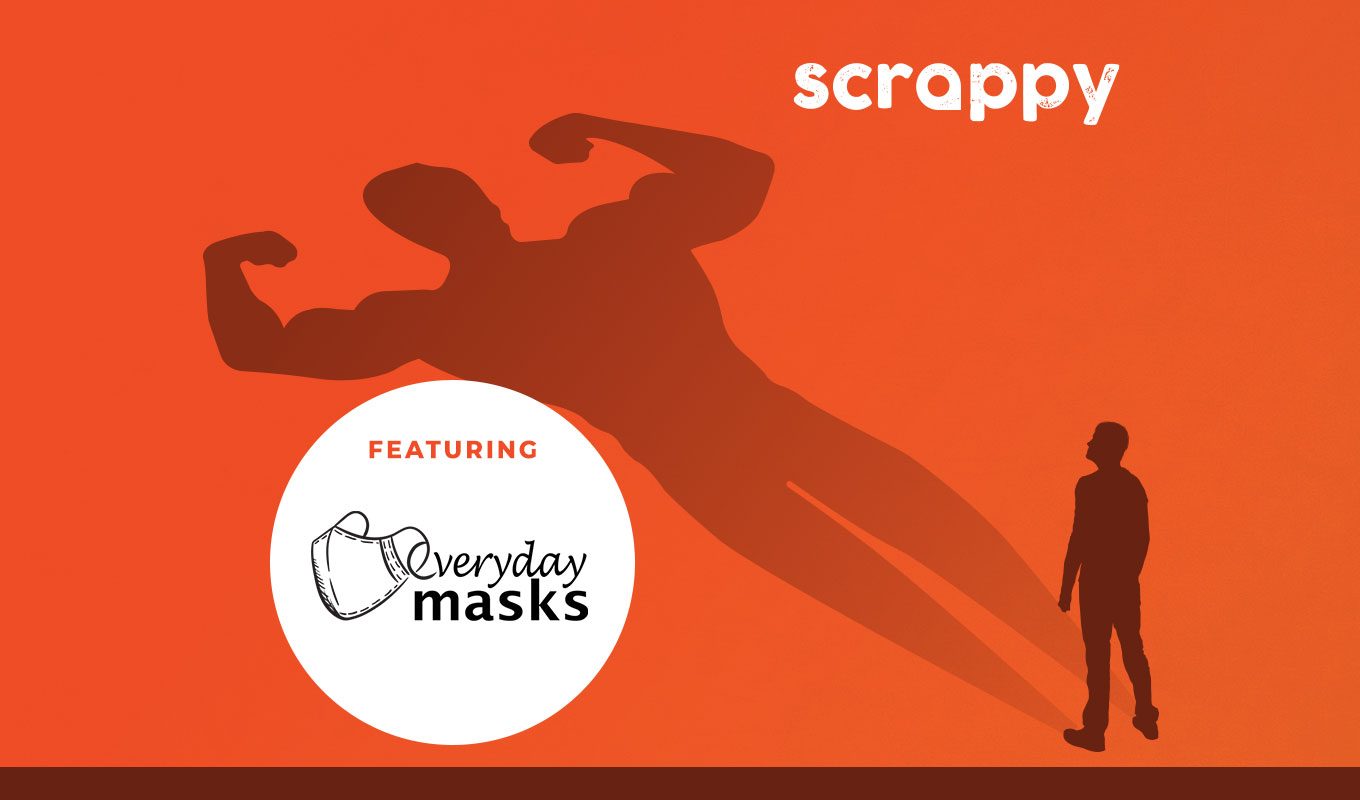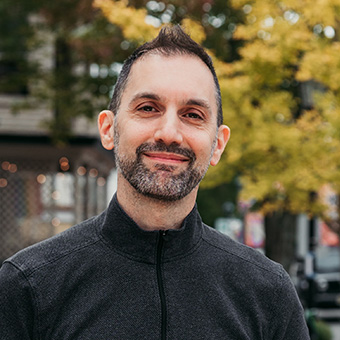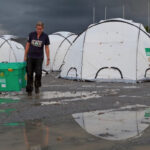
Everyday Masks
Podcast: Play in new window | Download
Staci Tinkelman and Becky Pyles realized early in the Covid-19 pandemic that masks were going to become a critical need – not just for front-line medical staff, but for the community at large. By combining Becky’s sewing talents and the infrastructure at Staci’s printing company, Quaker Chroma Imaging, they realized that they could help those in need, and get some of their people back to work.
LINKS:
Full Transcript
Chris Straigis – 0:01
Welcome to Scrappy the podcast about small companies doing big things. I’m your host, Chris Straigis.
So far 2020 has been a year of, shall we say, changes. We woke up in January, got our coffee, went to work, met with friends for drinks, watched the games. But by March, we could hardly recognize this world as new routines took over in what seemed to be like an instant. And we also had some trouble recognizing each other due to the rapid cultural shift of wearing masks. Early in the pandemic masks were front and center as news of shortages became the lead story.
Becky Pyles – 0:47
I did reach out to them actually to say “Hey, is this something that you need?” and they were all desperate. The need was starting to increase by the day.
Chris Straigis – 0:56
At first, it was just for medical professionals. The folks on the front line. But a small team from a fabric printing company in New Jersey saw a bigger picture. And with it, they saw a unique opportunity to get some of their team back to work and provide resources for people in need. Staci Tinkelman and Becky Pyles pooled their resources, their talent and their business infrastructure at Quaker Chroma Imaging to start a new product line called Everyday Masks.
Staci Tinkelman – 1:26
My name is Staci Tinkelman. My positioned at Quaker Chroma Imaging is Vice President of Digital Imaging. And my position at Everyday Masks is Co-Owner. I want to shout out to Becky Pyles.
Becky Pyles – 1:41
I am the Head of Sewing Department, and at Everyday Masks I am co owner.
Staci Tinkelman – 1:47
She is our head seamstress our Head of Sewing Department, and she is amazing at figuring out difficult structures, giant structures, how they’re going to be sewn. That’s not an easy thing to do. With darts and turns and corners and things, a lot of stuff has to happen. And she’s amazing at that.
Chris Straigis – 2:04
How many employees does Quaker Chroma have?
Staci Tinkelman – 2:08
Anywhere between 30 and 40 at any given time. Quaker Chroma Imaging has been around for quite a while in that it was originally two separate companies. And they formed, they merged together I think about 2004. And since then, it was a great partnership. We went through trials and tribulations with the economy over the years. We moved out to Jersey from Center City. We were going gangbusters just building building building until you know the COVID-19 happened.
Chris Straigis – 2:39
Your businesses chugging along at the beginning of 2020. And then all of a sudden COVID-19. Obviously, it was spreading around the world. News of things starting to shut down here in the States came pretty quickly. So walk me through what you were doing at that point. And how you guys were we’re sort of talking about how you were going to handle what seemed to be coming?
Staci Tinkelman – 3:06
COVID-19 came and everything shut down. And we had to leave. Becky’s at home making mass because people, nurses and people know she sews, and they’re asking her “I’m desperate I need it.” They don’t have any PPE, they need something. Hospitals are saying ‘go out and buy bandannas in the store.’ Craig and her were talking about this and they’re like “we could do this we could make these things, help people and keep people busy and and do something about it.”
Becky Pyles – 3:33
And need was great for people to get masks in hand that didn’t have any PPE available to them. So they were my very first customers. And then it spread quickly. To the couple of nurses in my circle or medical staff in my circle. I did reach out to them actually say “Hey, is this something that you need?” and they were all desperate. The need was starting to increase by the day. In working with the nurses, I came up with a sized option where the mask actually fits over your face by the size of your face. So small, medium, large based on, and extra large, based on your frame of your face. That way the mask can actually go underneath the PPE that they’re supplied.
And then for people in less risky situations, it was the only mask they’re wearing. And it was before the general public was even wearing masks that we started into production. So I went back to work check in let him know I was working on and brought this idea back, saying we could definitely do this. This is something that we can help, we can get masks out there. And the track was on trend to see that the regular public was going to need them as well. This wasn’t going anywhere. Working with our capabilities, which is printing, we were able to offer really unique designs really play the print to the scale of a mask, which you can’t just do with fabric.
The downside of doing masks for myself from home is, I could have gone and bought fabric from Joanne’s but they the commercially available materials are getting harder and harder to source. So going wholesale with the materials really made a big difference on the quality and quantity of fabric we can get. So the ability to bring other sewers who were all at home sewing their own masks for their own friends and family and make it available to the public at large. That was really the goal is to get it out into as many hands as possible and make the shift that we’re not used to. It’s a cultural shift to cover our faces that but unnecessary one unfortunately these times.
Chris Straigis – 5:58
When you decided to work through the company through Quaker Chroma to start utilizing this the scale basically scaling up what you were doing and utilizing the the potential of bulk fabric. What, how did you sort of land on the materials you were going to use? Aside from the the idea of of printing on them, what was… Were there specifications or regulations you had to consider when when you were thinking about you know, PPE for medical professionals?
Becky Pyles – 6:33
I product just to preface it’s not PPE for medical professionals. It is an added convenience for them or or an option when PPE isn’t available, or trying to extend the life of it. We don’t, we can’t say that it’s PPE in any way. You know, I’m saying it’s not licensed, it’s not CDC, it’s not anything along those lines. We chose the fabrics that we use primarily based off of the guidelines that were set across, there were like CDC type guidelines. There were people who are nurses who were making patterns saying what they needed or wanted out of a mask. Most of them boiled down to a couple of factors – they wanted cotton if being used in the medical facility because it can tolerate very high heat when it’s being sterilized. So they want to be able to wash it and have it wear well and not break down in the sterilization process. So cotton mask is definitely something we wanted to offer in case they weren’t being used in an augmentation of the PPE. But we definitely want to go with multi layer because it adds more protection. It’s best practice you know, in best practice, multi layer is better for you than single layer.
Chris Straigis – 7:51
How did you decide on what patterns to use in terms of the design?
Staci Tinkelman – 7:56
Becky, and I picked suggestions of what we thought people would want, you know, American flag, camo, different things. And even to this, to today we’re looking at switching it out and putting new ones in and changing things up. Just because of what we see out there what we think maybe younger people might want. It’s sort of funny how Becky and I are, you know, Becky’s younger than me, I’m the old person here. But um, what I print out a couple different options and there’s a lot of the girls here that are sewing and guys that are sewing are younger than us and we’re like, what do you like?
Becky Pyles – 8:35
We did get input from the sewing department and many of them have been through fashion design school so their eyes pretty good. So when we pulled ideas, we did like a little bit of a vote when people first got back saying what do you like, but we had pulled quite a few designs to pick from but we got some input from the 20 somethings to help us stay on trend.
Chris Straigis – 8:58
How many people do have sewing currently, doing masks?
Becky Pyles – 9:03
13, 13 sewers.
Chris Straigis – 9:05
You brought 13 people back?
Becky Pyles – 9:08
Yeah, well, more than that, because there’s the support staff, but there are 13 seamstresses, we brought back to sew.
Chris Straigis – 9:16
And how many masks have you made to date?
Becky Pyles – 9:18
Oh goodness.
Staci Tinkelman – 9:20
So here’s the thing, we do make both the cotton and the printed masks. And we do make more than, like, especially the cotton mask, because those a lot of the ones we’re donating, we make a lot more than we sell, because we do donate a lot of them. So it’s hard to…
Becky Pyles – 9:38
We’ve given away more than 1800 already. We’ve we’ve managed to connect with the Center for Family Services in New Jersey, and we’re able to donate to the group homes and the foster care system. So it’s been really good, fulfilling to help these groups that wouldn’t otherwise have had the resources to purchase this many masks
Chris Straigis – 10:01
These are washable, right?
Staci Tinkelman – 10:03
Absolutely, a hundred percent. Actually the cotton masks when you wash them are even more because they’re a little stiff at first because there’s three layers of cotton, but then when you, after you wash them, they’re like softer. You know it’s, you know, they they’re they seem to wash really well. I’ve washed mine several times and they seem to wash great.
Chris Straigis – 10:21
They become like a like a comfortable t-shirt.
Staci Tinkelman – 10:24
Exactly. Like you have your I have my favorite masks that I like to wear.
Chris Straigis – 10:28
Do you accessorize your masks with what you’re wearing that day?
Becky Pyles – 10:32
I do.
Chris Straigis – 10:33
See, there you go. Listen, we can we can be protected and fashionable all at the same time. What’s your most popular pattern?
Staci Tinkelman – 10:48
What do you think Becky?
Becky Pyles – 10:49
Really, the tie-dye has done a little bit better than whiskers. But I think the galaxy and the flag are the two that I would say are the most popular.
Chris Straigis – 10:58
Yeah. And what’s your favorite Becky?
Becky Pyles – 11:02
I just made a new one that says “Strong is the new pretty” so that’s my favorite.
Chris Straigis – 11:06
I like that! Strong is the new pretty? Well, that’s gonna be trending soon. You know, you know, like in the old comics when when somebody would curse and it would be just like a series of characters. Right? You know, it’s never like an asterisk and an exclamation. That would be a funny one. Have that just printed on the over the mouth.
Staci Tinkelman – 11:28
That would be awesome. Hey, can we use that?
Chris Straigis – 11:31
You can use that, yep, that’s for you
Staci Tinkelman – 11:33
Okay. Okay, Becky, I’m on it.
Chris Straigis – 11:43
Within a few days of my interview, I got a delivery from Staci and Becky. It was the mask that I joked about when we talked. They weren’t kidding about using the idea. You can actually now find it on their website along all of their other great designs. Oh, right, the website…
Becky Pyles – 12:00
The website address is everydaymasks.net. And then we are, you can also find us on Facebook, and you can find us on Instagram.
Chris Straigis – 12:13
We are hard at work on our next full season of Scrappy which we hope to have out by this fall. In the meantime, you can go back and listen to season one at scrappypod.com. You can also find us on Facebook, Twitter, and Instagram @scrappypod. We’d love to hear from you with feedback on any of our stories or ideas for people we could talk to for future episodes. Thanks for listening to Scrappy.



